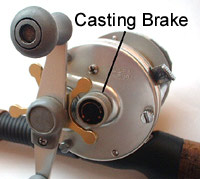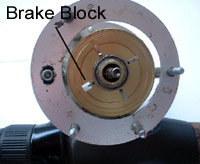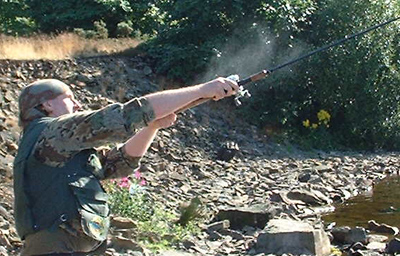| Many
anglers are put off using multiplier reels (also known as baitcasters) for their
lure fishing because of fear of over-runs and the mistaken belief that these reels
are complicated pieces of machinery. Don't panic! Multipliers are easy to get
to grips with. All you have to do is set them up correctly and practice a little.
 Initially
it is a good idea to set up the reel so that over-runs are impossible (or nearly
so). To do this rig up the reel on a rod ready to fish and attach a lure to the
trace. Reel the trace up to the tip ring and, holding the rod horizontally, disengage
the spool and allow the lure to drop unhindered. If the spool continues to revolve
when the lure hits the ground (throwing loose coils of line) the casting brake
is set too slack. Tighten this brake a little and repeat the process. By carefully
adjusting this brake you will arrive at a situation where the spool stops spinning
the instant the lure touches the ground. Because this brake acts directly on the
spool's spindle it should not be over tightened or the spindle might get distorted
and affect the performance of the reel. When changing to a lure of a different
weight you should re-adjust the casting brake. Initially
it is a good idea to set up the reel so that over-runs are impossible (or nearly
so). To do this rig up the reel on a rod ready to fish and attach a lure to the
trace. Reel the trace up to the tip ring and, holding the rod horizontally, disengage
the spool and allow the lure to drop unhindered. If the spool continues to revolve
when the lure hits the ground (throwing loose coils of line) the casting brake
is set too slack. Tighten this brake a little and repeat the process. By carefully
adjusting this brake you will arrive at a situation where the spool stops spinning
the instant the lure touches the ground. Because this brake acts directly on the
spool's spindle it should not be over tightened or the spindle might get distorted
and affect the performance of the reel. When changing to a lure of a different
weight you should re-adjust the casting brake.
 Most
multipliers have a centrifugal braking system which is intended to control the
speed of the spool during the cast. This braking system consists of a number of
small blocks which are thrown outwards to bear on a drum as the spool spins. Some
reels will have two blocks, others four and some might have more. By adding or
removing blocks you can alter the braking effect. When learning to cast with a
multiplier start out with more rather than less! Various sizes/weights of brake
block are also available. Plastic blocks (as shown here) come in white (heaviest),
black (lighter) and (apparently) blue (lightest), further aiding control. Older
models, and some current RHW models have fibre blocks which come in different
sizes. Fibre blocks can be fitted to non-UC models if that takes your fancy. Underfilling
the spool with line will also make the spool slower, and so reduce the chances
of over-runs. If you overfill the reel you will only end up cutting the line back
as you try to unravel tangles anyway. Thicker lines are less prone to causing
over-runs too as they cause the line level to drop more quickly. Light lures and
fine, springy nylon lines have probably accounted for the undeservedly bad reputation
multipliers have acquired over the years. Lures over an ounce in weight fished
on limp braided line automatically make over-runs less likely. Most
multipliers have a centrifugal braking system which is intended to control the
speed of the spool during the cast. This braking system consists of a number of
small blocks which are thrown outwards to bear on a drum as the spool spins. Some
reels will have two blocks, others four and some might have more. By adding or
removing blocks you can alter the braking effect. When learning to cast with a
multiplier start out with more rather than less! Various sizes/weights of brake
block are also available. Plastic blocks (as shown here) come in white (heaviest),
black (lighter) and (apparently) blue (lightest), further aiding control. Older
models, and some current RHW models have fibre blocks which come in different
sizes. Fibre blocks can be fitted to non-UC models if that takes your fancy. Underfilling
the spool with line will also make the spool slower, and so reduce the chances
of over-runs. If you overfill the reel you will only end up cutting the line back
as you try to unravel tangles anyway. Thicker lines are less prone to causing
over-runs too as they cause the line level to drop more quickly. Light lures and
fine, springy nylon lines have probably accounted for the undeservedly bad reputation
multipliers have acquired over the years. Lures over an ounce in weight fished
on limp braided line automatically make over-runs less likely.
 A
rod with a trigger grip reel seat is a real plus for lure casting with a multiplier.
The trigger will actually enable you to relax your grip on the rod and reel, the
rod almost hanging from your finger on the trigger. Having a comfortable grip
on the reel is important, and I like to have three fingers in front of the trigger
(others prefer to have just two), and to be able to get my entire thumb over the
spool. I feel that this gives me a better grip when casting heavy lures and prevents
the spool slipping during the cast. Adopt the grip which is most comfortable for
you. A
rod with a trigger grip reel seat is a real plus for lure casting with a multiplier.
The trigger will actually enable you to relax your grip on the rod and reel, the
rod almost hanging from your finger on the trigger. Having a comfortable grip
on the reel is important, and I like to have three fingers in front of the trigger
(others prefer to have just two), and to be able to get my entire thumb over the
spool. I feel that this gives me a better grip when casting heavy lures and prevents
the spool slipping during the cast. Adopt the grip which is most comfortable for
you. To make a cast it is preferable
to begin with the rod in front of you and your lure hanging about two feet below
the rod tip. The secret of casting with a multiplier is to keep your movements
fluid and smooth. Put your thumb on the spool, push the spool release and take
the rod back over your shoulder. When you feel the weight of the lure flex the
rod begin the forward cast and release the pressure of your thumb on the spool
as the rod begins to unload. If you have set the reel up correctly the spool should
stop spinning when the lure hits the water. Using
a rod which is balanced to the weight of the lures being used makes for smoother
and more accurate casts. Very stiff rods are difficult to cast smoothly with,
some degree of flex in the tip is desirable even when fishing with very heavy
lures. When striving for maximum distance, remember to aim high as in the photo
of Pete Wadeson below.
 With
your reel set up as described, you might notice that you can't cast your lures
as far as someone who has had more experience. Most likely this will be because
they have set their reels up to be more free running and are using their thumb
to control the spool. As in the picture above they might have removed a brake
block or two. It is also likely that their casting brake will be adjusted to apply
minimum pressure to the spool's spindle. Set up like this it is possible to cast
a wider range of lure weights without the constant need to adjust the casting
brake. An 'educated thumb' is the best braking system you can have. A well trained
thumb can sense when the line is starting to fluff up from the spool and automatically
apply pressure to slow the spool. Only when casting light, or unaerodynamic, lures
into a strong wind will you then need to concern yourself with the casting brake. With
your reel set up as described, you might notice that you can't cast your lures
as far as someone who has had more experience. Most likely this will be because
they have set their reels up to be more free running and are using their thumb
to control the spool. As in the picture above they might have removed a brake
block or two. It is also likely that their casting brake will be adjusted to apply
minimum pressure to the spool's spindle. Set up like this it is possible to cast
a wider range of lure weights without the constant need to adjust the casting
brake. An 'educated thumb' is the best braking system you can have. A well trained
thumb can sense when the line is starting to fluff up from the spool and automatically
apply pressure to slow the spool. Only when casting light, or unaerodynamic, lures
into a strong wind will you then need to concern yourself with the casting brake. When
you have mastered casting with a multiplier, which won't take long, you will come
to realise that it offers so many advantages over a fixed spool for lure fishing
that you will not want to return to a fixed spool reel as long as you live (unless
you fancy a bit of ultra-light fishing, that is). For lures in excess of one ounce
weight there is no contest - the multipliers have it! To
find out why I like Ambassadeurs go to A Reel Recommendation.
|